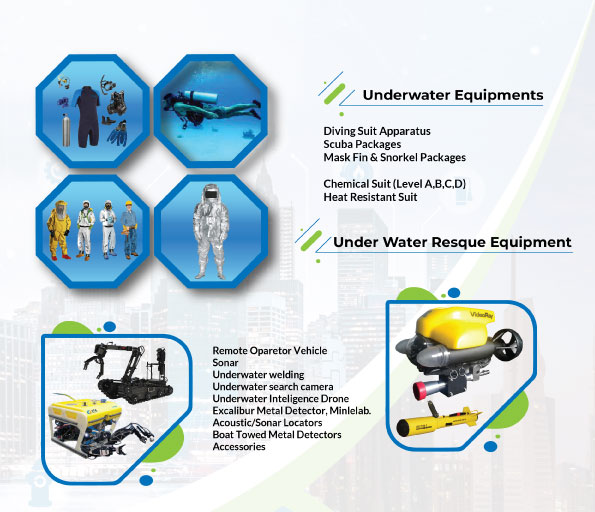+88 0192 0098535 : info@zmintl.com

















UNDERWATER EQUIPMENTS
Underwater Equipment refers to specialized tools and technologies designed for use in underwater environments. These tools are essential for various applications, including underwater exploration, scientific research, marine construction, environmental monitoring, and recreational activities such as diving. Here’s an overview of the key types of underwater equipment, their applications, and benefits:
1. Types of Underwater Equipment
1.1. Diving Equipment
Scuba Gear:
Description: Includes tanks, regulators, buoyancy control devices (BCDs), and wetsuits or drysuits, enabling divers to breathe underwater and maintain buoyancy.
Applications: Used for recreational diving, underwater research, and professional diving operations.
Full Face Masks:
Description: Masks that cover the entire face and allow for communication underwater.
Applications: Used in commercial diving and rescue operations for improved visibility and safety.
1.2. ROVs (Remotely Operated Vehicles)
Description: Unmanned, remotely controlled underwater vehicles equipped with cameras and tools for exploration and inspection.
Applications: Used in underwater research, offshore oil and gas inspections, and marine archaeology.
1.3. AUVs (Autonomous Underwater Vehicles)
Description: Unmanned underwater vehicles that operate independently and can be programmed for specific tasks.
Applications: Used for mapping, environmental monitoring, and data collection in deep-sea research.
1.4. Sonar Equipment
Types:
Side-Scan Sonar: Used to create images of the seafloor and detect submerged objects.
Multibeam Sonar: Used for mapping the seafloor by emitting multiple sound beams.
Applications: Employed in marine surveying, search and rescue operations, and underwater construction.
1.5. Underwater Cameras
Description: High-definition cameras designed to capture images and video underwater.
Applications: Used for marine research, wildlife observation, and recreational activities such as diving photography.
1.6. Underwater Lighting
Description: Specialized lighting systems designed for underwater use to enhance visibility during dives or underwater inspections.
Applications: Used in underwater photography, video production, and during nighttime underwater operations.
1.7. Underwater Communication Systems
Description: Systems that facilitate communication between divers or between divers and surface personnel.
Types:
Wired Communication Systems: Connect divers through cables.
Wireless Communication Systems: Use acoustic or radio frequencies for communication.
Applications: Essential for coordination in underwater operations, especially in commercial diving and search and rescue missions.
1.8. Underwater Survey Equipment
Description: Instruments for measuring and analyzing underwater environments.
Types:
Hydrographic Survey Equipment: Includes echo sounders and current profilers for mapping underwater topography.
Water Quality Sensors: Measure parameters like temperature, salinity, and turbidity for environmental monitoring.
Applications: Used in marine research, environmental assessments, and coastal management.
2. Applications of Underwater Equipment
Marine Research: Equipment is used to study marine life, underwater ecosystems, and geological formations.
Construction and Inspection: Tools are employed in underwater construction projects, such as bridge foundations and pipelines, as well as inspections of underwater structures.
Environmental Monitoring: Instruments monitor water quality and assess the impact of human activities on aquatic environments.
Recreational Diving: Provides divers with the necessary gear for safe and enjoyable underwater experiences.
Search and Rescue Operations: Underwater equipment is crucial for locating and recovering objects or individuals submerged in water.
3. Benefits of Underwater Equipment
Enhanced Safety: Proper diving gear and communication systems improve the safety of divers and underwater workers.
Increased Efficiency: Advanced technologies like ROVs and AUVs can cover large underwater areas quickly and gather data efficiently.
Comprehensive Data Collection: Various sensors and cameras enable detailed analysis and monitoring of underwater environments.
Facilitates Research and Exploration: Underwater equipment opens new frontiers in marine exploration and scientific discovery.
4. Challenges and Considerations
Environmental Conditions: Equipment must be designed to withstand pressure, temperature variations, and salinity levels in different underwater environments.
Maintenance and Reliability: Regular maintenance is crucial to ensure the equipment operates effectively and reliably in challenging conditions.
Training and Skill Development: Proper training for operators is essential to ensure safe and effective use of underwater equipment.
Conclusion
Underwater equipment plays a vital role in various sectors, enabling exploration, research, and operational tasks in aquatic environments. At ZM International, we offer a range of high-quality underwater equipment tailored to meet the needs of our clients, ensuring safety, efficiency, and effectiveness in underwater activities. Our solutions are designed to enhance the capabilities of marine professionals, researchers, and recreational divers, contributing to the overall advancement of underwater exploration and technology.






